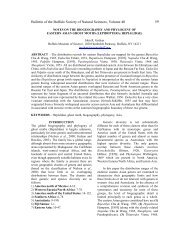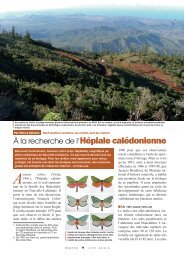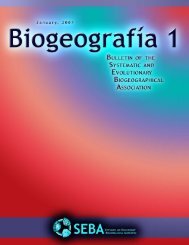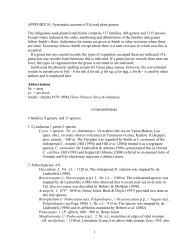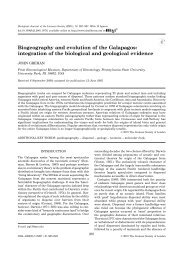You also want an ePaper? Increase the reach of your titles
YUMPU automatically turns print PDFs into web optimized ePapers that Google loves.
Druceiella momus (Druce, 1890)<br />
Hepialus momus Druce (1890: 508; fig. 3 [♂] dorsal); Equador,<br />
Sarayacu, Buckley leg.; coll. Druce; [GP P. Viet te no.<br />
BM Gen slide 2085]; [BMNH]. — Bertkau (1891: 196).<br />
Phassus momus: Kirby (1892: 890). — Wagner & Pfitzner<br />
(1911: 18).<br />
Pseudophassus momus: Pfitzner (1938: 1301; pl. 185e [♂]<br />
dorsal). — Zukowski (1954: 94).<br />
= Pseudophassus momus f. metricus Pfitzner (1938: 1301; pl.<br />
99h [♂] dorsal); Bolivia, Rio Songo, Fassl [leg.].<br />
Pseudophassus var. [sic] momus metricus: Forbes (1942: 406),<br />
as synonym of Dalaca metellus (Druce, 1890).<br />
Druceiella momus: Viette (1949a: 53; figs. 6 (8th ♂ tergite),<br />
7 (8th ♂ sternite), 8 (♂ gen.)). — Viette (1961: 6). — Ro binson<br />
& Nielsen (1984: 16), syn.: Druceiella metricus (Pfitz ner,<br />
1938). — Nielsen et al. (2000: 840), syn.: Dru cei ella metricus<br />
(Pfitzner, 1938).<br />
Druceiella nomus [sic]: Nielsen & Robinson (1983: 18), syn.:<br />
Druceiella metricus (Pfitzner, 1938).<br />
Druceiella metricus: Nielsen & Robinson (1983: 18); as synonym<br />
of Druceiella momus (Druce, 1890). — Robinson &<br />
Niel sen (1984: 16); as synonym of Druceiella momus (Druce,<br />
1890). — Nielsen et al. (2000: 840); as synonym of Druceiella<br />
momus (Druce, 1890).<br />
Gymelloxes Viette, 1952, stat. rev.<br />
Type-species: Dalaca terea Schaus, 1892, by original de signation.<br />
Gymelloxes Viette (1952b: 27); included species: terea<br />
(Schaus, 1892), trilinearis (Pfitzner, 1914).<br />
Paclt (1957: 51); as synonym of Aepytus Herrich-Schäffer,<br />
[1858]. — Edwards & Hopwood (1966: 114). — Nye &<br />
Fletcher (1991: 139).<br />
Aepytus (Gymelloxes): Nielsen & Robinson (1983: 19). —<br />
Ro bin son & Nielsen (1984: 17).<br />
Cibyra (Gymelloxes): Nielsen et al. (2000: 842). — <strong>Grehan</strong><br />
(2010: 44).<br />
Remarks. Gymelloxes Viette, 1952 was described mainly based on<br />
the ♂ genitalia characters, clearly distinct from the other genera.<br />
Therefore, we re-instate it here as a separate genus.<br />
Gymelloxes prosopus (Druce, 1901), comb. n.<br />
Hepialus prosopus Druce (1901: 436); Colombia, Bonda; coll.<br />
Druce; BMNH.<br />
Hepialus proposus [sic]: Wagner & Pfitzner (1911: 9).<br />
= Dalaca chiriquensis Pfitzner (1914: 105); [Panama], Chiri<br />
qui; coll. Pfitzner; [SMFL]; ◊ (1937: 1294; pl. 99b [♀]<br />
dor sal). — Schröder (1967: 339); lectotype [♀], SMFT 81.<br />
— Niel sen & Robinson (1983: 20). — Robinson & Niel sen<br />
(1984: 17). — Nielsen et al. (2000: 843); syn. n.<br />
= Dalaca muysca Pfitzner (1914: 105); [Panama], Chiriqui;<br />
coll. Pfitzner; [SMFL]. — Schröder (1967: 340); “holotype”<br />
[recte lectotype] [♀], SMFT 99, syn.: Dalaca terea<br />
Schaus, 1892; syn. n.<br />
Dalaca terea f. muysca: Pfitzner (1937: 1294; pl. 99f [♀]<br />
dorsal).<br />
Pseudophassus prosopus Pfitzner (1938: 1301).<br />
Aepytus (Gymelloxes) muysca: Nielsen & Robinson (1983: 19);<br />
as synonym of Aepytus (Gymelloxes) terea (Schaus, 1892).<br />
— Robinson & Nielsen (1984: 17); as synonym of Aepytus<br />
(Gymelloxes) terea (Schaus, 1892).<br />
Pfitzneriana prosopus: Nielsen & Robinson (1983: 19). —<br />
Ro bin son & Nielsen (1984: 17). — Nielsen et al. (2000: 841).<br />
Cibyra (Gymelloxes) muysca: Nielsen et al. (2000: 842); as<br />
syn onym of Cibyra (Gymelloxes) terea (Schaus, 1892).<br />
141<br />
Remarks. The lectotypes of Dalaca chiriquensis Pfitzner, 1914,<br />
Da laca muysca Pfitzner, 1914 and Hepialus prosopus Druce, 1901<br />
(here designated) were examined and all are conspecific. In the<br />
BMNH, there is one ♀ of Gymelloxes prosopus (Druce, 1901) that<br />
bears a label “type” which is here designated lectotype; it has the<br />
following labels: /Hepialus prosopus Druce type/ Bonda, Co lombia,<br />
150 ft., H. H. Smith/ Sept/ Joicey Coll. B.M. 1929–122/ Ex Coll.<br />
Herbert Druce 1913/. The designation is made to per ma nent ly<br />
stabilise the species’ identification.<br />
Gymelloxes terea (Schaus, 1892), comb. rev.<br />
Dalaca terea Schaus (1892: 330); Mexico, Paso de San Juan,<br />
Schaus leg.; coll. Schaus; [GP P. Viette 91513, type no.<br />
18603]; [USNM]. — Bertkau (1893: 190). — Druce (1898: 451;<br />
pl. 89, fig. 3 type [♂] dorsal). — Wagner & Pfitzner (1911:<br />
14). — Pfitzner (1937: 1294). — Schröder (1967: 340).<br />
Gymelloxes terea: Viette (1952b: 28; fig. 2 ♂ [syn-]type gen.);<br />
coll. Schaus; GP P. Viette 2240.<br />
Aepytus (Gymelloxes) terea: Nielsen & Robinson (1983: 19),<br />
syn.: Aepytus (Gymelloxes) muysca (Pfitzner, 1914). — Ro binson<br />
& Nielsen (1984: 17), syn.: Aepytus (Gymelloxes) muy sca<br />
(Pfitzner, 1914).<br />
Cibyra (Gymelloxes) terea: Nielsen et al. (2000: 842), syn.:<br />
Ci byra (Gymelloxes) muysca (Pfitzner, 1914). — <strong>Grehan</strong><br />
(2010: 51; fig. d appendix).<br />
Gymelloxes trilinearis (Pfitzner, 1914), comb. rev.<br />
Dalaca trilinearis Pfitzner (1914: 105); [Colombia], Sosomo<br />
co, 800 m, Fassl [leg.]; coll. Pfitzner; [SMFL]. — Fassl<br />
(1918: 19). — Schröder (1967: 340); “holotype” [recte lectotype]<br />
♂, SMFT 84; iii. 1911; GP Viette no. 2097.<br />
Dalaca trilinearides [sic]: Pfitzner (1937: 1294; pl. 99c [♂]<br />
dorsal).<br />
Gymelloxes trilinearis: Viette (1952b: 28); lectotype.<br />
[no genus] trilinearides [sic]: Zukowski (1954: 93).<br />
Aepytus (Gymelloxes) trilinearis: Nielsen & Robinson (1983:<br />
19). — Robinson & Nielsen (1984: 17).<br />
Cibyra (Gymelloxes) trilinearis: Nielsen et al. (2000: 842).<br />
Hampsoniella Viette, 1950, stat. rev.<br />
Type-species: Dalaca assa Druce, 1887 by original de signation.<br />
Aepytus (Hampsoniella) Viette (1950a: 74); included species:<br />
assa (Druce, 1887), equatorialis Viette, 1950, sladeni<br />
(Hampson, 1903).<br />
Edwards & Hopwood (1966: 116). — Nielsen & Robinson<br />
(1983: 19). — Robinson & Nielsen (1984: 17).<br />
Hampsoniella: Viette (1951b: 116). — Viette (1951d: 76). —<br />
Paclt (1953: 145); as synonym of Aepytus Herrich-Schäffer,<br />
[1856]. — Nye & Fletcher (1991: 141).<br />
Cibyra (Hampsoniella): Nielsen et al. (2000: 841). — Gre han<br />
(2010: 49; fig. f appendix).<br />
Remarks. Hampsoniella Viette, 1950 was described mainly based<br />
on the ♂ genitalia characters, clearly distinct from the other ge nera.<br />
Therefore, we re-instate it here as a separate genus.<br />
Hampsoniella assa (Druce, 1887), comb. rev.<br />
Dalaca assa Druce (1887: 232; pl. 24, fig. 10 [♂] dorsal);<br />
Gua temala, Volcan de Atitlan, 2500–3000 feet, and Panta<br />
leon, 1700 feet, Champion [leg.]; BMNH. — Kirby (1892:<br />
886). — Schaus (1894: 236). — Druce (1898: 450). — Wag ner<br />
& Pfitzner (1911: 13). — Dyar (1915b: 350). — Pfitzner (1937:<br />
1293; pl. 99c [♂] dorsal). — Forbes (1942: 406). — Biezanko<br />
(1961a: 8) [misidentification, unknown species].<br />
Aepytus (Hampsoniella) assa: Viette (1950a: 74; fig. 3 ♂ gen.)<br />
[error, unknown species; see Viette (1951c: 95)]. — Niel sen





